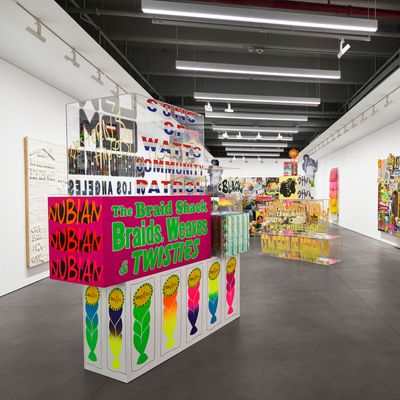
Stepping into Lauren HalseyÔÇÖs New York solo debut is like entering a bedazzled ark. David KordanskyÔÇÖs Chelsea gallery is packed with boxy installations on the floor and collaged panels that look like giant mood boards. There are abstract barges chockablock with stuff: images clipped from magazines, books, and the internet and objects that have been gathered from HalseyÔÇÖs hometown neighborhood in South Central Los Angeles. ItÔÇÖs a democratizing art spoken in a vernacular tongue of love and obsession, a spaceship filled with relics from the past that is hurtling toward a joyous future.
Now 35 years old, Halsey originally harbored dreams of being a professional basketball player. When she wasnÔÇÖt recruited, she studied architecture instead, then earned art degrees from CalArts and Yale. She was a standout resident of the Studio Museum in Harlem from 2014 to 2015 before returning to the South Central neighborhood that has served as both her medium and muse. In 2018, she created The Crenshaw District Hieroglyph Project, featuring a walk-in cube made of plywood and gypsum, inscribed on the inside and out with storefront logos, graffiti tags, and portraits of residents as if to suggest South Central is as worthy of reverence as the civilization of ancient Egypt.
Supply-chain issues postponed eastside of south central los angeles hieroglyph prototype architecture (I), a rooftop commission for the Metropolitan Museum of Art that was to channel the museumÔÇÖs ÔÇ£unparalleled Egyptian Art collections through the lens of Afrofuturism,ÔÇØ according to Met director Max Hollein. ItÔÇÖs scheduled to touch down there next spring. The systole of the pandemic presented other opportunities, however. She started an organization, Summaeverythang, that distributes organic produce to residents of Watts and South Central, where fresh food can have a tough time reaching. Halsey told the Los Angeles Times she is ÔÇ£super-committed to the idea of having a community center in my neighborhood that would support all sorts of intelligence for free at a very high level.ÔÇØ
Community is literally at the center of HalseyÔÇÖs new show. The installation My Hope is an oasis-metropolis of signs for local businesses (including ÔÇ£Waz Up! SportswearÔÇØ and ÔÇ£VanessaÔÇÖs Positive EnergyÔÇØ), shops, and other institutions (Summaeverythang makes an appearance), black-and-white and color cutout photos, a Black Nefertiti, plastic palm trees, a gold pyramid, Day-Glo muscle cars driving along a boulevard, and so much more. Halsey reverses polarities, bringing the street into the gallery.
HalseyÔÇÖs art can sometimes seem like a collage exploded into piecemeal assemblages. Her sculptural forms teem with imagery from Black culture, while her acrylic and wood constructions are covered in slogans. A white carbuncle shape, a malformed heart with various chambers, cantilevers from the wall ÔÇö officially untitled, though Halsey calls it a ÔÇ£funkmound.ÔÇØ ItÔÇÖs like a dancing planet with Black Kewpies, paper flowers, a yellow toy school bus, and an actual mini-waterfall falling behind a picture of a Black model basking in this grotto of imagined life. There are two huge collaged wall-pieces jam-packed with faces and hand-painted signs, including one that says ÔÇ£Florence,ÔÇØ a reference to the intersection where the Rodney King protests broke out in April 1992. Elsewhere, there are assemblages sporting durag packages, figurines, signs for Black churches, barbershops, beauty salons, and rainbow-colored synthetic hair. The show is like a magnificent flyover of a landscape teeming with life and activity. Here, I see the aesthetic faith of an artist who wonÔÇÖt be stopped from trying anything in her grand vision.
HalseyÔÇÖs three-dimensional rhapsodizing is reminiscent of what David Hammons has called ÔÇ£Negritude architectureÔÇØ: ÔÇ£Nothing fits, but everything works,ÔÇØ he says. ÔÇ£It doesnÔÇÖt have that neatness to it, the way white people put things together.ÔÇØ HalseyÔÇÖs art imposes the power of its own form on you; you feel the presence of an artistic light apart. There is also a sense that Halsey, along with an increasing number of Black artists, is rejecting the circumscribed ways much Black art is codified today. Endless didactic museum labels, reviews, and essays reduce this art to being about suffering and pain and victimhood. Black art is, of course, about those subjects, too, but HalseyÔÇÖs work, with its abundance and overflow and chika-chika visual beat, shows that it is about so much more and that our limiting discourse perpetuates stereotypes that curtail deeper conversations about the mysteries, perversities, and other uncontrollable qualities of art.
In Halsey, I glean an artist on the verge of letting her work erupt into sprawling, interconnected installations, giant Gesamtkunstwerks in the vein of Gaudi. I see an artist-genie summoning a modern Afrofuturist city, a great geography of the living and the dead, a place of pain and pleasure. This transcends old narratives of mourning and the accursed. Halsey is in the hope business. She talks about ÔÇ£not diluting or flattening subject and content.ÔÇØ She wants her art to be a ÔÇ£container for all these really beautiful moments,ÔÇØ ÔÇ£a portrait that comes from everyone from all angles,ÔÇØ ÔÇ£the complete experience of Blackness.ÔÇØ She gives us a universe already contained in South Central.

